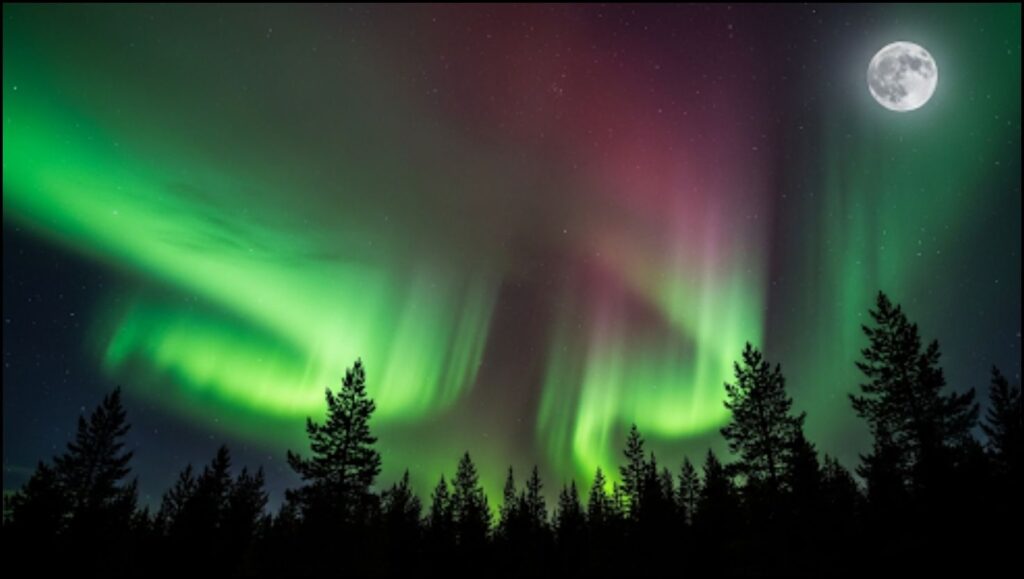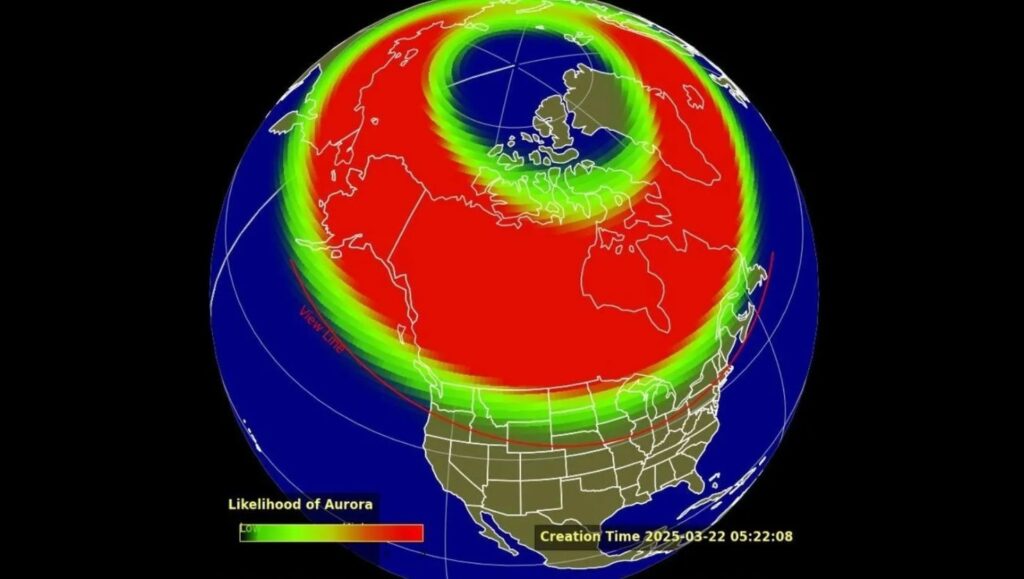Millions of people across the Northern Hemisphere may witness a rare and brilliant celestial display this weekend as a powerful solar storm is forecast to generate widespread Northern Lights. The event coincides with the rise of August’s Full Sturgeon Moon, creating a unique opportunity—and a potential challenge—for sky-watchers hoping to see the vibrant aurora borealis.

Powerful Geomagnetic Storm to Create Widespread Northern Lights
| Key Fact | Detail / Forecast |
| Primary Event | Widespread Aurora Borealis (Northern Lights) & Aurora Australis. |
| Cause | A strong G3-level geomagnetic storm. |
| Peak Timing | The night of Saturday, August 9, into the early morning of Sunday, August 10, 2025. |
| Lunar Event | August’s Full Sturgeon Moon, reaching peak illumination. |
| Viewing Challenge | Bright moonlight may wash out fainter auroral displays. |
A Powerful Storm from the Sun
The phenomenon began with a significant solar flare earlier this week. A powerful eruption, known as a coronal mass ejection (CME), propelled a massive cloud of charged particles and magnetic plasma toward Earth, according to the National Oceanic and Atmospheric Administration’s (NOAA) Space Weather Prediction Center (SWPC). The agency has issued a G3 “Strong” geomagnetic storm watch for the evening of August 9-10.
“When a CME of this magnitude reaches Earth, it interacts with our planet’s protective magnetic field, transferring energy into the magnetosphere,” said Dr. Alistair Finch, a professor of space physics at the University of Colorado Boulder. “This energy excites atoms and molecules in the upper atmosphere—primarily oxygen and nitrogen—causing them to glow in the distinct colors we know as the aurora.”
G3-level storms are strong enough to push the aurora significantly beyond its usual polar boundaries. Officials at the SWPC stated in a press release that the Northern Lights could be visible, weather permitting, as far south as Pennsylvania, Iowa, and Oregon in the United States. In Europe, the display may reach across the United Kingdom and as far south as Germany and Poland. A corresponding event, the Aurora Australis, will be visible in southern parts of Australia and New Zealand.

The Full Sturgeon Moon Complicates Viewing
Adding to the spectacle is August’s full moon, which reaches its peak illumination on the same night. Known as the Full Sturgeon Moon, its name has historical roots tied to the giant sturgeon that were most readily caught in the Great Lakes and Lake Champlain during this time of year, according to folklore compiled by The Farmer’s Almanac.
While beautiful in its own right, the moon’s brightness presents a significant challenge for aurora hunters. A full moon can act as natural light pollution, potentially washing out the fainter, more subtle details of the aurora.
“It’s a celestial competition between two light sources,” explained Dr. Evelyn Reed, an astronomer with the Planetary Science Institute. “The most intense, fast-moving parts of the auroral display should still be very impressive. However, the dimmer, static green glows that often linger might be harder to distinguish against a moonlit sky.” Experts advise that the best chance to see the full splendor of the aurora borealis will be after the moon sets in the early morning hours, just before dawn.
How to Watch for the Northern Lights
Despite the lunar interference, viewing conditions can be maximized with a few simple steps. The key is to find a location with a clear view of the northern horizon, far from city and suburban light pollution.
“Your eyes need at least 20 minutes to fully adapt to the darkness for optimal viewing,” noted a viewing guide from NASA. Patience is essential, as auroral activity can occur in bursts. The storm is expected to be most active between 10:00 PM and 2:00 AM local time. While the phenomenon is visible to the naked eye, modern smartphone cameras and DSLRs with manual settings can often capture the colors more vividly. Photographers are advised to use a tripod and a long exposure setting to capture the movement and structure of the lights.
The sun is currently in an active phase of its roughly 11-year cycle, known as Solar Cycle 25, which is expected to peak in 2025. This heightened activity increases the frequency and intensity of solar storms, promising more opportunities for celestial events like this one. “We are entering a very exciting period for space weather,” Dr. Finch added. “It’s a powerful reminder of our star’s dynamic and ever-changing influence on our world.
A Celestial Dance: Astronauts Share Unprecedented Views of Aurora from Space
